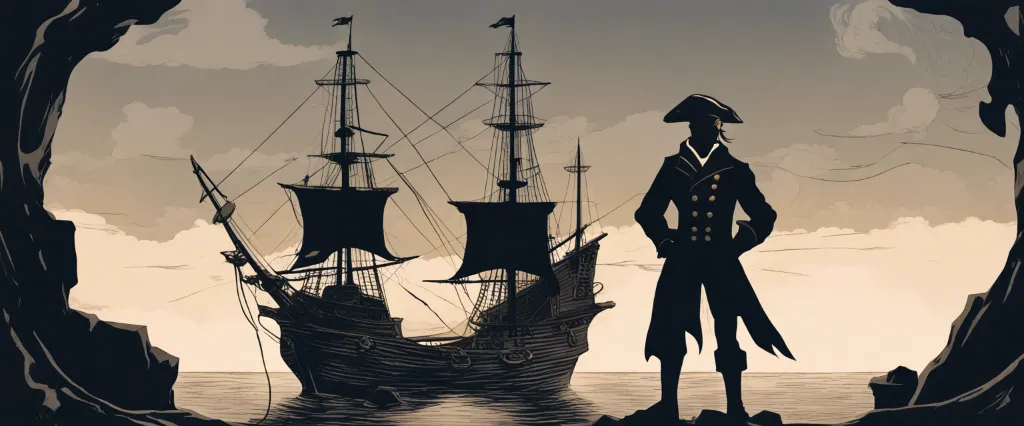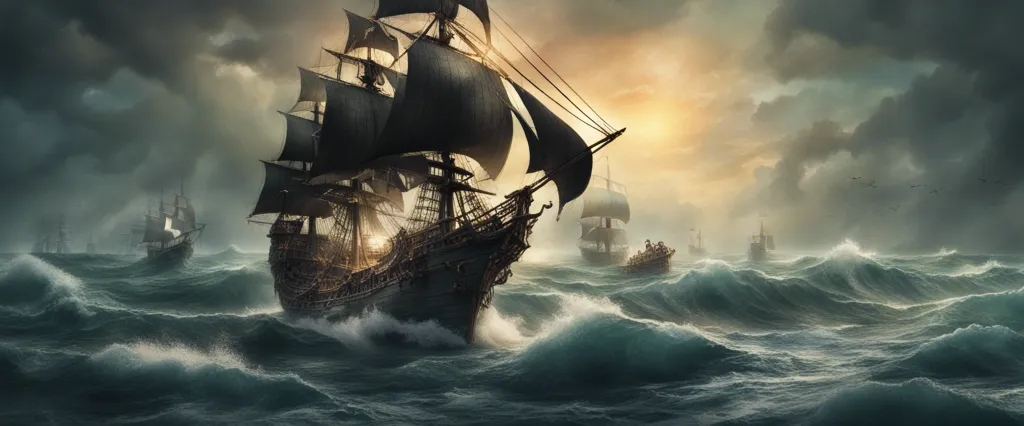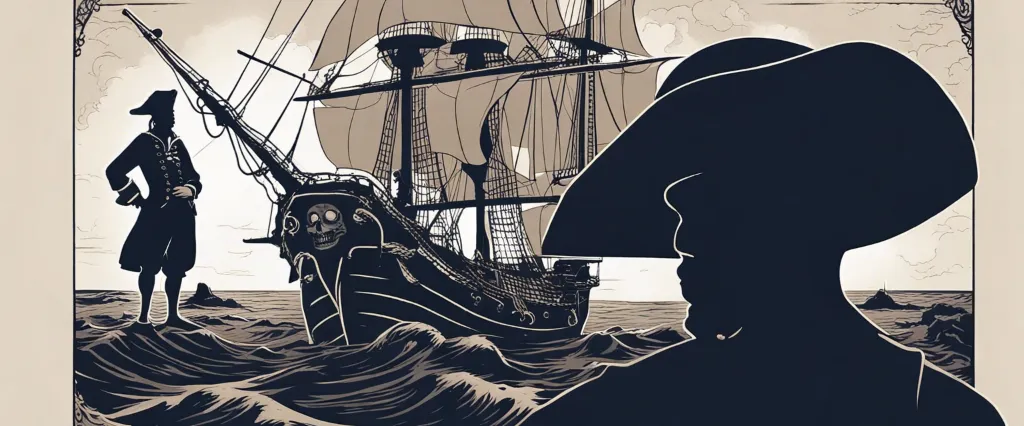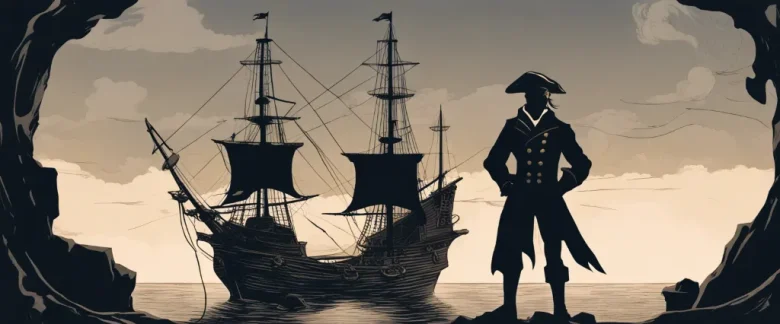
In “The Republic of Pirates,” Colin Woodard dives deep into the secret world of the Caribbean pirates during the Golden Age of Piracy. Revealing the untold history of legendary figures like Blackbeard, Anne Bonny, and Charles Vane, Woodard uncovers an astonishing narrative that defies the romanticized depictions of pirates we have come to know. A gifted historian, Woodard skillfully blends meticulous research with captivating storytelling, offering readers a gripping exploration of the true nature of piracy and its profound impact on the New World.
Chapter 1: The Golden Age of Piracy Emerges in the Caribbean
In Chapter 1: The Golden Age of Piracy Emerges in the Caribbean of the book “The Republic of Pirates” by Colin Woodard, the author provides an insightful overview of the historical context that led to the emergence of piracy in the Caribbean during the early 18th century. Woodard sets the stage by describing the political and socioeconomic conditions that prevailed in the region at the time.
He highlights the aftermath of the War of Spanish Succession, which left many sailors and privateers unemployed and facing uncertain futures. Some of these men turned to piracy as a means of survival, seeking a life of adventure and wealth. The author explains that this transition was facilitated by the abundance of privateers who had operated as legal pirates during the war, now finding themselves without legitimate targets for their plunder.
Woodard introduces key figures who played a significant role in the rise of piracy, such as Henry Jennings and Benjamin Hornigold. These men, alongside their crews, began preying on Spanish merchant ships, seeing this as a lucrative opportunity. However, rather than depicting pirates as mere criminals, Woodard illuminates their motivations, which often involved themes of rebellion against oppressive European powers and the search for freedom.
The author also discusses the influence of the Bahamas, particularly the island of New Providence, which became a haven for pirates due to its location and lenient British governance. With its deep harbor and lack of effective law enforcement, New Providence became a base for pirates to repair their ships, resupply, and socialize.
Overall, this chapter provides a captivating introduction to the factors that led to the Golden Age of Piracy in the Caribbean, including the post-war conditions, the motivations of individuals involved, and the importance of locations like New Providence. Woodard establishes that piracy in this era was a complex phenomenon, driven not only by criminal intent but also by a desire for freedom, adventure, and opportunistic plunder.
Chapter 2: The Brethren of the Coast: Pirate Democracy
Chapter 2: “The Brethren of the Coast: Pirate Democracy” from Colin Woodard’s book “The Republic of Pirates” delves into the establishment and functioning of pirate democracy within the infamous Brethren of the Coast in the early 18th century.
The chapter begins by introducing the concept of pirate democracy, which emerged as a response to the harsh conditions and brutal treatment faced by sailors in the legitimate maritime world. Pirate crews were formed by individuals from diverse backgrounds who shared a common goal: escaping the tyranny of their previous lives and embracing a democratic society aboard a pirate ship.
Woodard explores the unique governance structure of pirate crews, focusing on the implementation of the “Articles of Agreement.” These articles were a set of rules and regulations governing pirate behavior, punishments, and wealth distribution, which allowed pirates to establish fairness and equality among the crewmembers. The democratically elected captain held authority during combat, but decisions regarding navigation, crew welfare, and investments were made collectively, ensuring a level playing field.
Furthermore, pirate democracy extended to the division of plunder. Pirates practiced a form of collective wealth distribution where shares were assigned based on rank and contributions to the success of the venture. This system promoted solidarity and incentive, providing equal opportunity for both experienced sailors and former slaves to achieve wealth and status.
The chapter also highlights the significance of pirate bases, like New Providence Island in the Bahamas, where the Brethren of the Coast established a self-governed community. This pirate republic operated independently from colonial authorities, offering refuge and freedom to pirates. Local inhabitants, aware of the benefits brought by pirates to the economy, contributed to the maintenance of their operations.
In summary, Chapter 2 of “The Republic of Pirates” explores the democratic and egalitarian framework of the Brethren of the Coast. It emphasizes the establishment of fair governance through the Articles of Agreement, the collective division of plunder, and the creation of pirate-friendly havens. This chapter illustrates how pirate democracy allowed individuals to escape oppression, providing them with an opportunity for liberty, equality, and economic prosperity.
Chapter 3: Nassau: Pirate Haven in the Bahamas
Chapter 3 of “The Republic of Pirates” by Colin Woodard delves into the establishment and development of Nassau as a pirate haven in the Bahamas during the early 18th century.
The chapter begins with the arrival of the famous pirate Benjamin Hornigold in New Providence, Nassau, in 1713. Hornigold, a former privateer, recognized the strategic significance of Nassau due to its proximity to important trade routes and its natural harbor, making it an ideal base for pirate operations. Hornigold quickly seized control of the island, forcing the governor and his council to flee.
With Hornigold as the de facto ruler, Nassau began to transform into a pirate republic, attracting a diverse group of pirates from all over the Caribbean. The pirates established a crude form of government, electing representatives who formulated laws and regulations to maintain order within their ranks.
Woodard describes how the pirates in Nassau, including notorious figures like Edward Teach, better known as Blackbeard, and Charles Vane, engaged in piracy, plundering merchant vessels, and terrorizing the high seas. Despite their notoriety, the pirates had a unique sense of democracy, practicing equal distribution of plunder and adhering to a code that limited brutality towards captives.
However, tensions began to rise as some pirates sought alliances with European nations, while others preferred to remain independent. The arrival of Woodes Rogers, a British privateer, marked a turning point for Nassau. Rogers, appointed by the British government to bring an end to piracy, successfully broke the power of the pirates in Nassau through a combination of military force, amnesty offers, and promises of land grants.
In summary, Chapter 3 highlights the rise and fall of Nassau as a pirate haven in the Bahamas. It showcases the establishment of a pirate republic, the exploits of notorious pirates, and ultimately the decline of piracy in the region with the intervention of British authorities.
Chapter 4: The Pirate Code: Rules and Regulations

Chapter 4 of “The Republic of Pirates” by Colin Woodard delves into the Pirate Code, outlining the rules and regulations that governed the notorious 18th-century pirates. These pirates operated in the lawless waters around the Caribbean, taking advantage of weak colonial governments and engaging in acts of piracy and plunder.
Woodard begins by emphasizing that pirates had to create their own society and establish rules to maintain order amongst their ranks. The Pirate Code was a democratic system that allowed pirates to elect their leaders and make collective decisions. Every crew member had a say in decision-making processes, making their society remarkably egalitarian.
The Pirate Code covered various aspects of pirate life. It prohibited stealing from fellow pirates, engaging in fights within the crew, or bringing women on board their ships. Pirates were expected to share their loot equally, ensuring fair distribution and minimizing disputes. Dissenters who violated the code risked being marooned, abandoned on a deserted island with minimal supplies.
Pirates had a complex system of compensation for injuries sustained during battles, distinguishing themselves from other seafarers who often left injured individuals neglected. Their system ensured that sailors who lost limbs or suffered severe injuries received proper care and financial support.
Woodard also highlights the intriguing concept of “black spots” within the Pirate Code. A black spot was a powerful symbol given to individuals who were being accused of betraying or violating the code. This marked them for punishment, often leading to their expulsion from the crew or even their execution.
In summary, Chapter 4 explores the Pirate Code as a significant element of pirate society. It illustrates how pirates, who existed outside the realm of ordinary law, established rules and regulations to govern their communities. This code ensured fairness, equity, and order within their lawless world, creating a unique system that set them apart from other seafaring society.
Chapter 5: Captains and Crews: Pirate Leadership and Organization
Chapter 5 of “The Republic of Pirates” by Colin Woodard focuses on the leadership and organization within pirate crews during the Golden Age of Piracy in the early 18th century. Woodard explores how pirates, led by captains, formed democratic governments aboard their ships and established a unique code of conduct known as the pirate’s code.
Woodard explains that pirate captains were elected by their crew, often based on their abilities in combat and leadership, rather than by birthright or appointment. These captains held vast power but were also accountable to their crew. They had the authority to make tactical decisions, divide plunder, and negotiate with other ships, but they were subject to removal if they failed to meet the expectations of their crew, leading to an equal distribution of power and responsibility.
Furthermore, the pirate’s code was an unwritten set of rules that governed the behavior of pirates on their ships. It ensured fair treatment, democratic decision-making, and the distribution of food and wealth. This code also outlawed certain acts, such as stealing from fellow pirates or engaging in acts of violence towards women. The violation of the code could lead to punishments or even expulsion from the crew.
Woodard explores the stories of prominent pirate captains such as Edward “Blackbeard” Teach, Charles Vane, and “Calico” Jack Rackham. He highlights their different leadership styles, ranging from the fearsome and ruthless methods employed by Blackbeard to the more democratic and inclusive approach of Rackham.
Overall, Chapter 5 of “The Republic of Pirates” provides a glimpse into the complex leadership structures and codes of conduct that governed pirate crews during the Golden Age of Piracy, showcasing the unique and often democratic nature of their organizational systems.
Chapter 6: Plunder and Pillage: Pirate Raids and Treasure
Chapter 6 of “The Republic of Pirates” by Colin Woodard titled “Plunder and Pillage: Pirate Raids and Treasure” delves into the various tactics and operations employed by pirates during the Golden Age of Piracy in the early 18th century.
Woodard begins by noting the strategic importance of Nassau, the capital of the pirate haven in the Bahamas. This former British colonial outpost had been left abandoned, making it a perfect base for pirates to use as their operational headquarters. With its natural harbor, proximity to major shipping routes, and lack of enforcement, Nassau became a hub for pirates to plan and launch their raids on merchant vessels.
Woodard then outlines the structure and methods of pirate crews, highlighting the democratic nature of pirate ships where captains were elected and crew members had a say in decision-making. These crews were often a mix of nationalities and backgrounds and built around camaraderie and shared goals, providing somewhat of a democratic contrast to the oppressive navies of the time.
The author delves into the famous pirate captains Anne Bonny and Mary Read, their roles in pirate crews, and their fearless nature. Woodard also focuses on the notorious pirate Blackbeard, discussing his intimidation tactics such as tying slow-burning fuses into his beard to create a terrifying image during battles.
Furthermore, the chapter explores the types of ships favored by pirates and the various techniques they employed in raids, including the boarding, pillaging, and destruction of merchant vessels. The pirates often inflicted brutal violence on crews that resisted, using their reputation to their advantage in subduing victims quickly.
Finally, Woodard provides an intriguing insight into the piracy lifestyle, discussing the distribution and consumption of pirate loot, as well as the attempts by authorities to suppress their activities with the implementation of the “Pirate Acts.”
In Chapter 6 of “The Republic of Pirates,” Colin Woodard effectively captures the dynamic world of pirate raids, showcasing the tactics, characters, and lifestyle that prevailed during the Golden Age of Piracy.
Chapter 7: The End of an Era: Pirates Hunted and Captured
Chapter 7 of “The Republic of Pirates” by Colin Woodard, titled “The End of an Era: Pirates Hunted and Captured,” chronicles the decline and ultimate demise of the Golden Age of Piracy in the early 18th century.
By the early 1720s, the British government had grown weary of the rampant piracy destabilizing colonial trade routes. They responded by initiating a major crackdown on pirates, deploying naval forces, and offering generous pardons to encourage pirates to abandon their criminal exploits. However, while some pirates accepted the pardons and became privateers or settled into more legitimate lives, others continued to pillage and plunder.
The chapter begins by examining the story of pirate Charles Vane, who refused to accept the pardon and roamed the seas with a small band of followers, stoking fear in the Caribbean. However, Vane’s luck eventually ran out, and he was captured by pirate-hunter Jonathan Barnet.
Woodard also delves into the story of Calico Jack Rackham, Anne Bonny, and Mary Read, three notorious pirates whose exploits captured the public’s imagination. Eventually, they too were caught by pirate hunters and sentenced to death, although Bonny and Read managed to escape the gallows by claiming to be pregnant.
The final section of the chapter focuses on Woodes Rogers, a former privateer who was appointed as the governor of the Bahamas by the British government to restore order and end piracy. Rogers managed to successfully crush the remaining pirate strongholds in the region, including the infamous pirate haven of Nassau.
This chapter marks the end of the era of “pirate utopias” and highlights the government’s growing control over the seas, signaling the decline of piracy as a way of life. Woodard’s account serves as a testament to the changing tides and the eventual suppression of piracy by state authorities.

Chapter 8: Legacy of the Pirates: Myth and Reality
Chapter 8 of “The Republic of Pirates” by Colin Woodard, titled “Legacy of the Pirates: Myth and Reality,” explores the lasting impact of piracy on not only the Caribbean but also on global culture and our understanding of the pirate era.
Woodard starts by discussing how the Golden Age of Piracy, which lasted roughly from 1650 to 1730, has been romanticized and mythologized over the centuries. This romanticized image of swashbuckling pirates and their daring adventures has captivated the popular imagination, leading to the creation of enduring fictional characters such as Captain Jack Sparrow from Pirates of the Caribbean. However, Woodard emphasizes that the reality of piracy was far different from the fictionalized version.
He points out that pirate crews were diverse and often functioned under democratic rules, creating a proto-republic that defied the hierarchical structure of society at the time. Pirates were, in essence, social revolutionaries who challenged the established order. This aspect of their legacy can be seen in various forms of resistance against tyranny throughout history.
Woodard also highlights the important economic impact of piracy. By disrupting global trade routes and attacking colonial powers, pirates played a significant role in shaping the development of capitalism and the modern world. Moreover, the pirate-infested waters of the Caribbean forced European powers to unite and establish naval forces to combat piracy, setting the stage for the rise of modern navies.
However, Woodard cautions against romanticizing piracy entirely. He reminds readers that pirates were primarily criminals who pillaged and murdered, often causing immense suffering. Despite the occasional stories of noble pirates resisting oppression, their true legacy is one of outlawry and brutality.
In conclusion, the legacy of the pirates is paradoxical. On one hand, their actions influenced the development of democracy, capitalism, and modern navies. On the other hand, their ruthlessness and disregard for law and order remind us of the dark side of piracy, contrasting with the romanticized image that has pervaded popular culture.
After Reading
In conclusion, Colin Woodard’s book “The Republic of Pirates” provides a captivating and thoroughly-researched account of the Golden Age of piracy in the seventeenth and eighteenth centuries. He explores the rise and fall of notorious pirate havens such as Nassau and Port Royal, shedding light on the social and economic factors that led to their establishment. Through vividly depicting the lives of famous pirates such as Blackbeard and Calico Jack, Woodard successfully unravels the myths and reveals the reality of their exploits. Furthermore, he delves into the complex political dynamics between pirates, colonial powers, and the merchant class, displaying how even the most feared individuals could manipulate the interests of those in power. “The Republic of Pirates” not only provides a thrilling adventure through piracy’s heyday, but also offers a thought-provoking analysis of the period’s impact on global history and the development of America. Overall, Woodard’s book serves as an engaging and insightful chronicle of a fascinating era that continues to captivate modern audiences.
1. Genghis Khan and the Making of the Modern World” by Jack Weatherford: This captivating historical account offers an in-depth exploration of the life and legacy of the infamous Mongolian warlord, Genghis Khan. Weatherford skillfully weaves together a fascinating narrative, revealing how Khan’s leadership and innovative strategies shaped the course of history.
2. Sweetness and Power” by Sidney W. Mintz: Delve into the intriguing world of sugar and its impact on society, as Mintz uncovers the complex history and cultural significance of this ubiquitous commodity. From its origins in colonial plantations to its role in global trade and consumption, Mintz provides a thought-provoking analysis of how sugar has shaped power dynamics and social structures.
3. The Information” by James Gleick: In this thought-provoking exploration of the history and significance of information, Gleick takes readers on a journey through the evolution of communication and the impact it has on our lives. Thoughtfully researched and expertly written, this book offers insights into how information has transformed societies and shaped human progress.
4. Sapiens: A Brief History of Humankind” by Yuval Noah Harari: Prepare to be confronted with profound questions about the nature of being human. Harari’s compelling narrative takes readers on a sweeping journey from the emergence of Homo sapiens to the present, examining the pivotal events, ideas, and revolutions that have shaped our species. Through an interdisciplinary approach, he poses thought-provoking theories about our past, present, and future.
5. The Guns of August” by Barbara W. Tuchman: Step into the gripping world of politics, military strategy, and diplomacy during the outbreak of World War I. Tuchman’s meticulous research and engaging storytelling bring to life the events leading up to the war, providing readers with a deep understanding of the complexity and tragic consequences of this pivotal historical moment. This classic read captures the essence of a bygone era and offers valuable insights into the human condition during times of crisis.



